| Article ID | Journal | Published Year | Pages | File Type |
|---|---|---|---|---|
| 4343694 | Neuroscience Letters | 2014 | 6 Pages |
•A profile of speech and emotion encoding was obtained in a 28-min ERP recording.•Also attention allocation towards emotional information in speech was evaluated.•This paradigm is suitable for studies on language and/or emotion processing.
We developed a new multi-feature mismatch negativity (MMN) paradigm with two improvements: Firstly, the standard tone, a pseudoword /ta-ta/ was presented with equal probability to the nine linguistically relevant deviants, reducing the recording time by 45%. Secondly, three rare, emotionally valenced stimuli: happy, angry, and sad utterances of the standard pseudoword were included in the sequence. MMN signals reflecting the perceptual properties of the sounds were observed for all stimuli. In addition, P3a signals were observed for the rare emotionally uttered pseudowords. This 28-min paradigm allows a multi-dimensional evaluation of central speech–sound representations (MMN), and attention allocation (P3a) to emotional information content of speech. We recommend this paradigm for studies on subject groups with impairments in language or emotional information processing, such as autism spectrum disorders, attention disorders, and alexithymia.
